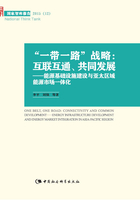
版权信息
书名:“一带一路”战略:互联互通、共同发展:能源基础设施建设与亚太区域能源市场一体化
作者:李平,刘强等
出版社:中国社会科学出版社
出版时间:2015-09
ISBN:9787516169230
本书由中国社会科学出版社授权上海阅文信息技术有限公司进行制作与发行
版权所有·侵权必究
课题组成员:李平 刘强 董惠梅 刘金朋胡安俊 杨惜春
Members:LI Ping, LIU Qiang, DONG Huimei, LIU Jinpeng, HU Anjun, YANG Xichun
摘要:《“一带一路”战略:互联互通、共同发展》是第四届全球能源安全智库论坛的主题报告,由中国社会科学院数量经济与技术经济研究所课题组完成。
《报告》认为,能源安全是全世界共同关心的重大问题。中国作为全球能源消耗最大的国家,能源安全问题尤其突出。在经历了改革开放30多年的快速发展后,中国经济进入新常态。这既为我们进行结构调整,实现产业升级和解决社会问题提供了机遇,也使我们面临新的问题和挑战。
“一带一路”战略对于各国能源合作意义重大。中国提出了建设“丝绸之路经济带”和“21世纪海上丝绸之路”的发展构想,这一战略构想既与中国能源进口的陆上与海上通道相吻合,有助于加强中国与沿线国家的能源联系,同时也有助于通过能源与交通基础设施、商业金融与投资合作促进区域融合发展,消除各国之间的发展鸿沟,消除产生极端主义、恐怖主义的土壤。如果这一构想能够有效实施,将给世界带来超出预想的共同利益。
能源合作既要重视基础设施互联互通,也要考虑货币、资本、商贸、金融合作,推动形成亚洲能源共同市场。参考北美和欧盟的能源共同市场的成功经验,通过共享金融平台的方式推动形成亚洲能源共同市场。《报告》建议,推动建设东北亚、中亚和东南亚三个区域性的能源共同市场,并依托“21世纪海上丝绸之路”战略建设东亚、东南亚的天然气交易中心。建议推动以下重点项目。
1.连接东北地区、环渤海地区与俄罗斯远东地区、蒙古国部分地区的天然气供应网络,把北方深水良港曹妃甸建设成中俄东段天然气管线,中亚和西气东输管线,来自西亚、东南亚、澳大利亚的海上液化天然气进口三大供给线与环渤海、东北亚巨大消费市场相衔接的,集储运、交割、结算为一体的天然气市场,形成辐射东北亚、东南亚的天然气交易中心。这将有效调整我国的能源结构,促进京津冀协同发展,减轻大气污染。这一战略将使“21世纪海上丝绸之路”与草原之路、丝绸之路交互融合、形成亚洲新的经济增长点。
2.推动中国中亚能源管线与中巴经济走廊、西亚能源网络的互联互通,实现中国西部、中亚五国、巴基斯坦和西亚地区、里海沿岸地区经济的融合发展。这一地区覆盖了大约2亿人口,拥有丰富的能源资源和市场潜力,是丝绸之路经济带的重点发展领域。实现这一发展目标,将大大推动中东地区的和平与发展进程,给全世界带来重大的安全利益。
3.推动中国与东盟的能源合作,包括加强中国南方电网与缅甸、老挝、越南、泰国、柬埔寨等国电力项目的互联互通,形成区域性电力网络,利用清洁的水电资源改善南方地区的能源结构;加强中国与新加坡、马来西亚、印度尼西亚、文莱等国在石油和天然气领域的合作,加快东亚和东南亚地区油气市场的进一步融合与东亚定价中心的形成。
关键词:“一带一路”战略,能源安全,天然气交易中心,能源互联互通
Abstract: The theme report for the 4th Global Forum on Energy Security Conference is completed by the Task Force of The Institute of Quantitative & Technical Economics(IQTE)of Chinese Academy of Social Sciences(CASS).
The energy security is recognized as a critical global issue of common concern. As the world's largest energy consuming country, China is facing an extremely serious energy security situation. After a rapid development for three decades since the reform and opening-up, China's economy has entered the New Normal, which not only provides us with opportunities for the structural adjustment, industry upgrading and social problems solving, but also brings new problems and challenges.
“One Belt, One Road”initiative is significant for the international energy cooperation. China puts forward the development concept of building“Silk Road Economic Belt”(SREB)and“21 stCentury Maritime Silk Road”(MSR). This strategic concept is accordance with China's inland and maritime energy import passage, which will help strengthen the energy ties between China and the countries along the passage. On the other hand, it will help to promote the regional integration and development, eliminate the development gap between different nations and eliminate the cradle for the extremism and terrorism through the cooperation in energy and traffic infrastructures, commercial, finance, and investment. If effectively implemented, it will bring our world more common interests beyond the anticipation.
For energy cooperation, it is necessary to highlight the infrastructure interconnection, as well as the currency, capital, trade, financial cooperation in order to promote the development of a common energy market in Asia. In reference to the successful experiences of common energy market in North America and the European Union, the common energy market in Asia can be developed by sharing the financial platforms. It is suggested in the report to promote the construction of three regional energy common markets in North-East Asia, Central Asia and Southeast Asia, and to construct natural gas trading centers for Eastern Asia and Southeast Asia by means of the“21 stCentury Maritime Silk Road”Strategy. The following key projects are highly recommended.
A. The report puts forward to build the northern deep-wa ter port, Caofeidian, as the natural gas market where the three major pipelines, namely eastern section of China-Russia natural gas pipeline, Central Asia and West-East Gas Pipeline and the offshore liquefied natural gas(LNG)import pipeline from the Western and Southeast Asia and Australia, are connected with the huge consumer market in circum-Bohai-Sea(CBS)region and Northeast Asia. To fulfill this target, it is necessary to connect the natural gas supply networks between China's northeast region and CBS region with that in Far East regions of Russia and part of the Republic of Mongolia. This natural gas market will integrate storage, delivery and billing into one system, and affect the area of Northeast and Southeast Asia. This will effectively adjust the China's energy structure, promote the cooperative development of Beijing, Tianjin and Hebei province(BTH), and reduce the air pollution. This strategy will enable the combination of the“21 stCentury Maritime Silk Road”with Grassland Road and Silk Road, forming a new economic growth point in Asia.
B. To promote the interconnection between China-Central Asia energy pipelines with Pakistan-China economic corridor and the Western Asia energy networks for cooperative economic development of the western China, the five Central Asian countries, Pakistan as well as Western Asia and the Caspian coastal region. This area has a population of approximately 200 million, and has rich energy resources and market potential, therefore, making itself the key development area of the Silk Road Economic Belt. It will greatly promote the peace and development process in the Middle East and bring the world with significant security benefits if this development goal is fulfilled.
C. To push the energy cooperation between China and ASEAN, including enhancing the connectivity between China's Southern Power Grid and the electricity projects in Myanmar, Laos, Vietnam, Thailand, Cambodia to form a regional electricity networks, thus to improve the energy structure in southern China with clean hydropower. Also it is better to strengthen the cooperation between China and Singapore, Malaysia, Indonesia, Brunei and other countries in oil and gas and speed up the further integration of oil and gas markets in Eastern and Southeast Asia and the formation of pricing centre in Eastern Asia.
Key Words: “One Belt One Road”lnitiative, Energy Security, Natural Gas Hub, Energy Connectivity
能源安全是全世界共同关心的重大问题。中国作为全球能源消耗最大的国家,能源安全问题尤其突出。在经历了改革开放30多年的快速发展后,中国经济进入新常态。这既为我们进行结构调整,实现产业升级和解决社会问题提供了机遇,也使我们开始面临新的问题和挑战。